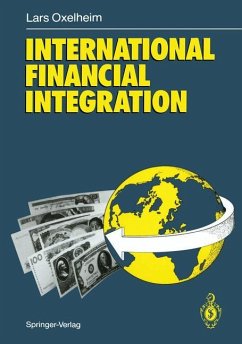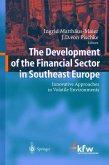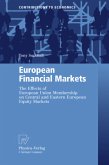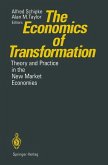Lars Oxelheim
International Financial Integration
Lars Oxelheim
International Financial Integration
- Broschiertes Buch
- Merkliste
- Auf die Merkliste
- Bewerten Bewerten
- Teilen
- Produkt teilen
- Produkterinnerung
- Produkterinnerung
There is widespread agreement in the current social and economic debate that the nations of the world are becoming increasingly integrated. Many structural signs in society also suggest that this is so. Integration has become a catchword in the prepara tions for the internal market of the EC, and a keynote in the debate about association for the European countries which do not belong to the Community. But when we turn to the question of how this integration should be measured, there is very little con sensus. Instead there are numerous problems, not only about how to measure integra tion but…mehr
Andere Kunden interessierten sich auch für
![The Development of the Financial Sector in Southeast Europe The Development of the Financial Sector in Southeast Europe]() Ingrid Matthäus-Maier / J.D. von Pischke (eds.)The Development of the Financial Sector in Southeast Europe39,99 €
Ingrid Matthäus-Maier / J.D. von Pischke (eds.)The Development of the Financial Sector in Southeast Europe39,99 €![50 Years of EU Economic Dynamics 50 Years of EU Economic Dynamics]() 50 Years of EU Economic Dynamics160,49 €
50 Years of EU Economic Dynamics160,49 €![European Financial Markets European Financial Markets]() Tony SouthallEuropean Financial Markets74,99 €
Tony SouthallEuropean Financial Markets74,99 €![Ageing, Financial Markets and Monetary Policy Ageing, Financial Markets and Monetary Policy]() Alan Auerbach / Heinz Herrmann (eds.)Ageing, Financial Markets and Monetary Policy116,99 €
Alan Auerbach / Heinz Herrmann (eds.)Ageing, Financial Markets and Monetary Policy116,99 €![The Economics of Transformation The Economics of Transformation]() The Economics of Transformation37,99 €
The Economics of Transformation37,99 €![The Impact of Brexit on Financial Markets. An In-Depth Analysis of the Foreign Exchange, Stock, and Government Bond Markets in the UK The Impact of Brexit on Financial Markets. An In-Depth Analysis of the Foreign Exchange, Stock, and Government Bond Markets in the UK]() Andrea BügerThe Impact of Brexit on Financial Markets. An In-Depth Analysis of the Foreign Exchange, Stock, and Government Bond Markets in the UK29,95 €
Andrea BügerThe Impact of Brexit on Financial Markets. An In-Depth Analysis of the Foreign Exchange, Stock, and Government Bond Markets in the UK29,95 €![China's Emerging Financial Markets China's Emerging Financial Markets]() James R. Barth / John A. Tatom / Glenn Yago (ed.)China's Emerging Financial Markets75,99 €
James R. Barth / John A. Tatom / Glenn Yago (ed.)China's Emerging Financial Markets75,99 €-
-
-
There is widespread agreement in the current social and economic debate that the nations of the world are becoming increasingly integrated. Many structural signs in society also suggest that this is so. Integration has become a catchword in the prepara tions for the internal market of the EC, and a keynote in the debate about association for the European countries which do not belong to the Community. But when we turn to the question of how this integration should be measured, there is very little con sensus. Instead there are numerous problems, not only about how to measure integra tion but even about how to define it. In this book I shall discuss the import and implications of a particular type of integration, namely financial integration, and then look at the most important problems connected with measuring it. In the empirical investigation reported below I felt the need for an integrated micro-macro approach. Further, I decided to illustrate the measurement problems by studying a small and relatively open economy where exchange controls have been imposed by the government in an attempt to reduce the flow of interest-sensitive capital out of the country, and thus to acquire autonomy for the national monetary policy. An interview study has been carried out with a view to illustrating among other things how expectations are formed among the major actors on the financial market, and this provided additional input for an analysis of the level of financial integration.
Produktdetails
- Produktdetails
- Verlag: Springer / Springer Berlin Heidelberg / Springer, Berlin
- Artikelnr. des Verlages: 978-3-642-64779-6
- Softcover reprint of the original 1st ed. 1990
- Seitenzahl: 412
- Erscheinungstermin: 27. September 2011
- Englisch
- Abmessung: 242mm x 170mm x 23mm
- Gewicht: 702g
- ISBN-13: 9783642647796
- ISBN-10: 3642647790
- Artikelnr.: 36115005
- Verlag: Springer / Springer Berlin Heidelberg / Springer, Berlin
- Artikelnr. des Verlages: 978-3-642-64779-6
- Softcover reprint of the original 1st ed. 1990
- Seitenzahl: 412
- Erscheinungstermin: 27. September 2011
- Englisch
- Abmessung: 242mm x 170mm x 23mm
- Gewicht: 702g
- ISBN-13: 9783642647796
- ISBN-10: 3642647790
- Artikelnr.: 36115005
In this comprehensive investigation Lars Oxelheim describes how financial markets in individual countries are steered by the events on the world market. The book is an important document of practical value for decision-makers in corporations, banks as well as in the political world. By elaborating the concept of financial integration and alternative ways of measuring the level of this integration, this study is also of great academic interest.
1 The Global Interdependence of National Financial Markets.- 1.1 Many signs of increasing market integration.- 1.2 Previous integration studies demonstrate difficulties in measurement and interpretation.- 1.3 The aim is to measure the level of financial integration.- 1.4 Different forms of financial integration.- 1.5 Interest rate differential or capital flow as dependent variable?.- 1.6 What types of interest rate are relevant to an analysis of financial integration?.- 1.7 What interest rates are the "leaders", as the influence of the US rate declines?.- 1.8 Why is the level of financial integration interesting in a macro-perspective?.- 1.9 What is the significance of the level of financial integration in a micro or corporate perspective?.- 1.10 Is the interest rate in a small open economy determined on foreign markets?.- 1.11 Growing uncertainty raises demands for higher risk premiums.- 1.12 The internationalization of trade.- 1.13 The internationalization of financing.- 1.14 The internationalization of production.- 1.15 Design of the analysis.- 1.16 Plan of the book.- 2 What Is Financial Integration, and Can It Be Measured?.- 2.1 Introduction.- 2.2 Are interest rates determined at home or abroad?.- 2.3 Capital flows and the links between markets.- 2.4 Exchange rate determinants and market expectations.- 2.5 Transaction costs and different types of risk premium.- 2.6 The link between risk and return.- 2.7 Financial integration and monetary autonomy - some measures and analytical approaches.- 2.8 Applied definition and the choice of model.- 2.9 Disintegration and monetary autonomy by way of controls.- 2.10 Problems of measurement and standardization.- 2.11 Collecting primary data.- 2.12 Concluding comment on the methodological problems.- 2.1 Fisher (Domestic)Effect.- 2.2 Variability in interest rates after tax.- 2.3 The International Fisher Effect.- 2.4 Model for determining the exchange rate.- 2.5 Example of a portfolio approach.- 2.6 The interest rate parity theory.- 2.7 Swedish industrial groups with a turnover exceeding SEK 1 billion in 1981.- 3 Results and Findings from Earlier Studies of Financial Integration.- 3.1 Introduction.- 3.2 Studies of the interest-sensitivity of capital flows.- 3.3 Equal expected returns as an indicator of direct financial integration.- 3.4 Observations from the literature - a summary.- 3.1 Adjusting portfolios in an open economy.- 4 Characteristic Features of the Financial Market in a Small Open Economy - the Case of Sweden.- 4.1 Introduction.- 4.2 Actors on the Swedish financial market.- 4.3 Rates of interest and administrative control mechanisms.- 4.4 Swedish exchange controls and their effect on segmentation.- 4.5 The Swedish krona - historical exchange rate patterns and the formation of expectations on the market.- 4.6 Specific measurement problems.- 4.1 Date of abolition of monetary policy regulations, 1978-85.- 4.2 Exchange rate index.- 4.3 Standard deviations in the forward and spot rates.- 4.4 Foreign exchange flows 1974-84.- 4.5 Current account reporting according to SCB.- 5 Fluctuations in Swedish Interest Rates - Historical Patterns.- 5.1 Introduction.- 5.2 Nominal and real Swedish interest rates 1974-84.- 5.3 Correlation between successive quotations of Swedish interest rates.- 5.4 The interest rate pattern and direct financial integration.- 6 Swedish Interest Rate Fluctuations in an International Perspective.- 6.1 Introduction.- 6.2 How Swedish nominal interest rates deviate from foreign interest rates.- 6.3 Deviations of Swedish real interest rates from foreignreal interest rates.- 6.4 What does this initial comparison suggest about financial integration?.- 7 Swedish Interest Rate Dependence: A Correlation Analysis.- 7.1 Introduction.- 7.2 Covariation between Swedish and foreign real interest rates.- 7.3 Covariation between the Swedish nominal interest rate and the foreign rate.- 7.4 Covariation between the Swedish interest rate and the forward-covered foreign interest rate.- 7.5 The correlation analysis and direct financial integration.- 8 A Model-Based Analysis of Direct Financial Integration.- 8.1 Introduction.- 8.2 Analysis of deviations from the International Fisher Effect.- 8.3 Analysis of deviations from interest rate parity.- 8.4 The forward rate as an unbiased estimate of the future exchange rate.- 8.5 Presentation of the model.- 8.6 Analysis of the gap between Swedish and foreign discount rates.- 8.7 Analysis of the gap between Swedish and foreign interest rates on treasury discount notes.- 8.8 Analysis of the gap between Swedish and foreign prime rates.- 8.9 Analysis of the gap between the Swedish interest rate on government bonds/government notes and the corresponding foreign rate.- 8.10 Analysis of the gap between Swedish and foreign interest rates on industrial bonds.- 9 Interest Rate Autonomy and the Foreign Dependence of the Swedish Financial Market - A Summary.- Supplement 1 Mean and standard deviation in the international interest rates 1974-84.- Supplement 2 List of variables and abbreviations.
1 The Global Interdependence of National Financial Markets.- 1.1 Many signs of increasing market integration.- 1.2 Previous integration studies demonstrate difficulties in measurement and interpretation.- 1.3 The aim is to measure the level of financial integration.- 1.4 Different forms of financial integration.- 1.5 Interest rate differential or capital flow as dependent variable?.- 1.6 What types of interest rate are relevant to an analysis of financial integration?.- 1.7 What interest rates are the "leaders", as the influence of the US rate declines?.- 1.8 Why is the level of financial integration interesting in a macro-perspective?.- 1.9 What is the significance of the level of financial integration in a micro or corporate perspective?.- 1.10 Is the interest rate in a small open economy determined on foreign markets?.- 1.11 Growing uncertainty raises demands for higher risk premiums.- 1.12 The internationalization of trade.- 1.13 The internationalization of financing.- 1.14 The internationalization of production.- 1.15 Design of the analysis.- 1.16 Plan of the book.- 2 What Is Financial Integration, and Can It Be Measured?.- 2.1 Introduction.- 2.2 Are interest rates determined at home or abroad?.- 2.3 Capital flows and the links between markets.- 2.4 Exchange rate determinants and market expectations.- 2.5 Transaction costs and different types of risk premium.- 2.6 The link between risk and return.- 2.7 Financial integration and monetary autonomy - some measures and analytical approaches.- 2.8 Applied definition and the choice of model.- 2.9 Disintegration and monetary autonomy by way of controls.- 2.10 Problems of measurement and standardization.- 2.11 Collecting primary data.- 2.12 Concluding comment on the methodological problems.- 2.1 Fisher (Domestic)Effect.- 2.2 Variability in interest rates after tax.- 2.3 The International Fisher Effect.- 2.4 Model for determining the exchange rate.- 2.5 Example of a portfolio approach.- 2.6 The interest rate parity theory.- 2.7 Swedish industrial groups with a turnover exceeding SEK 1 billion in 1981.- 3 Results and Findings from Earlier Studies of Financial Integration.- 3.1 Introduction.- 3.2 Studies of the interest-sensitivity of capital flows.- 3.3 Equal expected returns as an indicator of direct financial integration.- 3.4 Observations from the literature - a summary.- 3.1 Adjusting portfolios in an open economy.- 4 Characteristic Features of the Financial Market in a Small Open Economy - the Case of Sweden.- 4.1 Introduction.- 4.2 Actors on the Swedish financial market.- 4.3 Rates of interest and administrative control mechanisms.- 4.4 Swedish exchange controls and their effect on segmentation.- 4.5 The Swedish krona - historical exchange rate patterns and the formation of expectations on the market.- 4.6 Specific measurement problems.- 4.1 Date of abolition of monetary policy regulations, 1978-85.- 4.2 Exchange rate index.- 4.3 Standard deviations in the forward and spot rates.- 4.4 Foreign exchange flows 1974-84.- 4.5 Current account reporting according to SCB.- 5 Fluctuations in Swedish Interest Rates - Historical Patterns.- 5.1 Introduction.- 5.2 Nominal and real Swedish interest rates 1974-84.- 5.3 Correlation between successive quotations of Swedish interest rates.- 5.4 The interest rate pattern and direct financial integration.- 6 Swedish Interest Rate Fluctuations in an International Perspective.- 6.1 Introduction.- 6.2 How Swedish nominal interest rates deviate from foreign interest rates.- 6.3 Deviations of Swedish real interest rates from foreignreal interest rates.- 6.4 What does this initial comparison suggest about financial integration?.- 7 Swedish Interest Rate Dependence: A Correlation Analysis.- 7.1 Introduction.- 7.2 Covariation between Swedish and foreign real interest rates.- 7.3 Covariation between the Swedish nominal interest rate and the foreign rate.- 7.4 Covariation between the Swedish interest rate and the forward-covered foreign interest rate.- 7.5 The correlation analysis and direct financial integration.- 8 A Model-Based Analysis of Direct Financial Integration.- 8.1 Introduction.- 8.2 Analysis of deviations from the International Fisher Effect.- 8.3 Analysis of deviations from interest rate parity.- 8.4 The forward rate as an unbiased estimate of the future exchange rate.- 8.5 Presentation of the model.- 8.6 Analysis of the gap between Swedish and foreign discount rates.- 8.7 Analysis of the gap between Swedish and foreign interest rates on treasury discount notes.- 8.8 Analysis of the gap between Swedish and foreign prime rates.- 8.9 Analysis of the gap between the Swedish interest rate on government bonds/government notes and the corresponding foreign rate.- 8.10 Analysis of the gap between Swedish and foreign interest rates on industrial bonds.- 9 Interest Rate Autonomy and the Foreign Dependence of the Swedish Financial Market - A Summary.- Supplement 1 Mean and standard deviation in the international interest rates 1974-84.- Supplement 2 List of variables and abbreviations.








